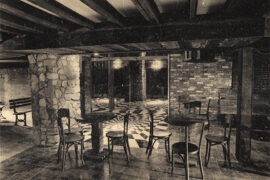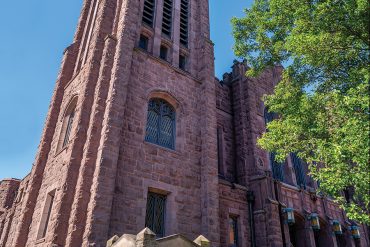Mary Leaberry, who turned 100 this year, has witnessed much of Huntington’s history. As the city marks its 150th anniversary, she shares her most indelible memories.
By James E. Casto
HQ 113 | SPRING 2021
Mary Leaberry and her twin sister Helen were born on July 18, 1921, at a maternity hospital in Chicago. Their parents, Ernest and May Leaberry, were both from England. In 1923 they moved the girls and their three brothers to Huntington where Ernest had found work as a salesman. But it wasn’t long before Ernest returned to Chicago and only saw his children briefly every few years. As such, May was left to care for their five children by herself. Despite being raised by a single mother, Mary and Helen went on to live rich and rewarding lives in Huntington.

For Mary, there were highs and lows over the span of the last 99 years including the Great Depression. When Mary was a teenager, her mother served as a foster parent to two children to help make ends meet. That meant there were eight people living in the family’s small two-bedroom house on 22nd Street West. It may be hard to fathom, but times were so tough in the 1930s that families literally could not afford to provide for their children.
“My mother was paid $5 a week per child by the government,” Mary recalled. “Everyone was so poor in those days.”
One little girl was brought to live with the Leaberrys when she was just two days old. Her name was Rebecca, and she would live with them for the next six years. Then her birth mother, who was living in Charleston, sent for her.
“Rebecca’s mother did not come see her one time in six years,” Mary explained. “Then suddenly she telephoned my mother and told her to put Rebecca on a bus to Charleston. Well, my mother refused. She told her, ‘I cannot do that. You need to come and talk to her and explain what is going on.’”
The birth mother eventually showed up, and what happened next is still vivid in Mary’s memory.

“She was quite upset with my mother and grabbed Rebecca by the hand and marched her down the sidewalk to the bus stop. I’ll never forget when Rebecca turned and waved goodbye to us. It was terribly sad. We all thought of her as a sister.”
At one point during the Depression, Mary’s uncle approached her mother and offered to adopt Helen and one of her brothers. He was financially secure and assured her that he could pay for their education and provide them with a good life.
“Mother told him, ‘Absolutely not! I will not break up my family, especially the twins,’” Mary said. “My mother was a very strong, independent woman. I admired her.”
Despite the hardships during the Depression, there were some fond memories including trips to Dreamland Pool and, of course, Camden Park.
“Dreamland was a big deal for us,” Mary said. “The giant slicky slide there was always a big hit. I remember the bus ride when our older brother Harry took us to Camden Park for the first time. There were so many rides, and we loved them all. And I remember the hill behind our home that we would slide down on our sleds in winter.”
The family worshipped at St. Peter’s Episcopal Church on Adams Avenue. Mary remembered that at Thanksgiving packages would arrive from the family’s relatives in England.
“Our aunt in England would send plum puddings,” she said. “The pudding was a special treat because each serving contained a British coin called a ‘threepenny bit.’ The coins were of little value, but our brothers passed them off as dimes because they were so similar in size and appearance.”
Come Christmas, the traditional tree was brought home by her brothers. Homemade decorations were the norm. The best gift that Mary remembered was a secondhand kid’s roll-top desk that she and her sister shared.
Mary recalled the 1937 flood that inundated much of Huntington. The rising waters of the Ohio River forced her from her home, and she ended up staying with friends who lived on higher ground.
“During the 1937 flood I remember so many people being evacuated from their homes in boats,” she said. “When I finally returned to our house there were water stains on the second floor.”

The youngsters attended Jefferson Elementary School, a six-block walk from their West Huntington home. They later remembered that almost every day they would carry peanut butter and jelly sandwiches for their lunch. That menu continued when the twins moved on to West Junior High School. They then graduated from Huntington High School in 1939.
Although the two sisters always remained close, they would follow very different paths after high school.
Helen fell in love with Dr. Fred Lester, a local dentist. They married and raised three children. She worked first at Appalachian Power Co., then for a while at the International Nickel Company (INCO) and later was employed at her husband’s dental office. She loved golfing, gardening and playing bridge. After being diagnosed with cancer at the age of 66, her husband passed away.
Mary never married. After high school she enrolled at the School of Nursing at St. Mary’s Hospital. Graduating as a registered nurse in 1942, she volunteered for the U.S. Army.
“I was commissioned a 2nd Lieutenant and was shipped to an Army hospital in England,” she said. “For the next two years, I spent long hours treating young men who had suffered some of the most horrible wounds you can imagine. There is no amount of training that could prepare you for the condition of those young men when they returned from the front lines. Twelve-hour shifts were common, weekends meant nothing and the memories of each day would often make sleeping difficult.”
Following the war, she decided not to re-enlist and returned to Huntington. Before returning, she did manage to visit with her aunt in England.
Back in Huntington, she worked as a nurse at INCO. She took care of the company’s huge workforce and even made house calls to retired employees.
“She was one of the first home health care workers,” said her niece Sally Bogers. “She would go to the homes of INCO’s pensioners and help them and their spouses. From medical care to bathing to house work, she made sure all their needs were met.”
Mary retired after 30 years of service.
“INCO was a great place to work,” Mary said. “The landmark Huntington plant has changed names and ownership over the years, but I’m very glad to see that it’s still here.”
Some of Mary’s fondest memories of Huntington were from the 1950s when the city’s population peaked at nearly 90,000 people.

“I enjoyed shopping for my nephews and nieces, especially at Christmastime,” she said. “Back then downtown Huntington was bustling with people. Some of my favorite shops were Anderson-Newcomb, The Princess Shop, Brown’s Apparel, Nassar’s and The Smart Shop.”
When the Civil Rights Movement came to Huntington in the 1960s, she was reminded of something her mother taught her and her siblings about how to treat Black people.
“You treat them the same! ‘They’re as good as you are and you’re as good as they are,’ my mom insisted. She thought people treated them terribly, which of course they did.”
As Mary and her sister neared their 90s, they became residents at Huntington’s Woodlands Retirement Community. On Oct. 16, 2000, 99-year-old Helen passed away. Mary still resides at Woodlands and will celebrate her 100th birthday in July.
“I have to say they take really good care of me here,” she said of the Woodlands staff.
Like her late sister, Mary is an avid bridge player. She plays twice a week.
“To be honest, I’m not very good at it,” she laughed, “and when I sometimes win I worry that they might just be letting me do so.”
She also enjoys bingo and said she hates it when bridge and bingo are scheduled at the same time so that she has to choose one or the other.
Mary keeps busy. She watches a little television. Wheel of Fortune is her favorite program. After learning to crochet, she began making comfort garments for Hospice of Huntington.
Looking back on the last 99 years, Mary said she has been blessed. When asked why she never left Huntington, she simply smiled. “That’s easy. It’s home,” she said.





